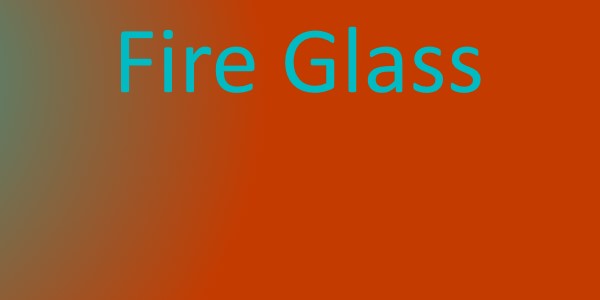
Are you wondering how to use fire glass? What is fire glass? Can you use fire glass in a wood burning fireplace? Are you wondering how to use fire glass? Get these questions and more answered in the most comprehensive fire glass guide on the internet!
Fire glass is rapidly replacing fake logs and artificial lava rocks as the go-to decorative piece for fire pits that use propane or natural gas fire burners. They are being used in celebrity homes, upscale hotels, and the fire pits of the affluent. They provide a unique and aesthetically pleasing base for your fire.
What Is Fire Glass?
Fire glass is glass that has been heat tempered. This means that it can withstand higher temperatures than normal glass before it begins to melt/pop/smoke/cause-a-nuisance. Heat tempered glass also breaks into less jagged/sharp pieces when broken. Many varieties of commercial fire glass are shaped and tumbled to avoid sharp edges and to produce a pleasing shape. Fire glass also tends to come in a number of different colors, sizes, and shapes. This allows the designer complete control when designing a fireplace.
Fire Glass creates a more appealing flame by creating a diffusion of the propane or natural gas used in the fireplace. This diffusion causes the flames to be more spread out, as opposed to shooting straight up in an unnatural-looking flame column.
How to Use Fire Glass Crystals
Fire glass is generally used by placing the glass in a tray that is designed to hold them. Once the tray is full, simply turn on the gas and then light it. The flames will appear to come from the glass and will shimmer beautifully.

Can You Use Fire Glass In a Wood Burning Fireplace?
This is a surprisingly common question. The simple answer is no. Fire glass is designed to be used in an approved pit with a propane or natural gas burner. Burning real logs with fire glass is not something the glass is designed for. The charcoal and ash from real logs would create a horrendous mess, as it would sink into the cracks in between the glass. Aside from the mess, adding real logs would greatly change the thermal composition of the fire. Fire glass is designed to be used with approved burners; burners apply a much more steady amount of heat and are easier to control.
Now if your questions is: Can I convert a wood burning fireplace into a gas fueled fire pit? The answer is: absolutely. However, that kind of conversion is beyond the scope of this article, as there are safety factors to consider.
Do Fire Glass Fires Produce A Lot Of Heat?
Fire glass in a burner pan will radiate more heat than artificial logs. This increase in heat is due to the reflective surface of fire glass.
Types of Fireplaces
Fire glass can be used in outdoor, vented, and non-vented fireplaces. If you use fire glass indoors in a vent-free fireplace, make sure you use a vent-free approved burner system.
Propane Vs Natural Gas
I have seen some reports that Natural gas may be preferable to propane. This is because natural gas burns cleaner and produces less carbon or soot build-up. Natural gas is also lighter than propane.In some setups, the heaviness of propane can cause it to build up beneath the burner surface. This may cause flare-ups or combustion under the surface…which can raise temperatures above what the glass is rated for. Propane does however produce more BTU’s due to its density. Just remember that most fire glass is designed to be usable with either natural gas or propane.As always, check with the specific manufacturer.
Will fire glass change the color of my fireplace?
It shouldn’t. Usually when fire changes color that is evidence of a chemical reaction beyond normal combustion. If you see fire glass that changes the color of your flame be weary, and do additional research to ensure its safety.
Can I Use Other Types Of Cheaper Glass
No, most glass is not tempered, and some glass is inlaid with plastic. Non tempered glass may explode. Exploding glass does not make for fun get-togethers and glass inlaid with plastic will give off toxic fumes when burnt. Ultimately, it’s much easier to just pony up and buy fire glass from a knowledgeable manufacturer. You will have a safer and more beautiful result this way.
Other Safety Concerns
Almost all manufacturers of fire glass go to great lengths to avoid glass with sharp edges. They also try to avoid filling their packages with irritating glass dust. HOWEVER, many packages do end up containing sharp pieces. I have also seen many packages that have a very fine dust on both the inside and outside of the package. This dust can made of tiny glass particles, and it is incredibly irritating when it gets stuck on your skin. It’s unpleasant when this happens, and if you are worried about it, I highly recommend you wear gloves when working with fire glass. I have seen some people recommend gloves even when you are just handling the packaging. How you ultimately do this is up to you, but I recommend at least considering handling gloves.

How is Glass Tempered?
First, the glass is prepared for tempering. If the glass needs to be cut or sanded, this must be done BEFORE the tempering process. After the glass is cut into the proper shape, it must be examined for any imperfections. Imperfections may cause the glass to break during or after the tempering process
The glass is then treated with heat or with treating chemicals. Most tempered glass is made by the heat method, however i’m not sure which method is used for most fire glass. When the glass is tempered by heat, the glass is fed into an oven which is heated to more than 620 Celcius (roughly 1150 fahrenheit). After the glass is heated up, it goes under a cooling procedure called quenching. Quenching heated glass consists of blasting high-pressure air into the glass. This air causes the outside of the glass to cool at a faster rate than the center of the glass.
This difference in cooling gives the glass interesting structural properties. The center of the glass remains in tension, and the outer layer goes into compression. If you fell asleep during high school physics and can’t remember exactly what that means, fear not! An object bearing a tension load is being pulled apart. At the molecular level, the molecules inside the objects are pulling together and trying to not be pulled apart. An object under a compression load is being squeezed. Inside the object being squeezed the molecules are pushing back and trying to stay apart to avoid being crushed.
Glass in tension breaks about 5 times easier than it does when it is in compression. Simple annealed glass will break at about 6000 pounds per inch. While tempered glass that adheres to federal specifications will have a surface compression of about 10,000 psi. Tempered glass will often break at about 24000 psi. In order for tempered glass to be “up to spec”, it needs an minimum surface compression of 10,000 psi, or and edge compression of more than 9700 psi. Again, these are general estimates, always check with the manufacturer if you are unsure.
When the glass is tempered by the chemical methods, certain chemicals are added to the surface of the glass that ultimately create that compression layer just as in the heating method.
There is also another process which creates what is called heat-strengthened glass. In this process the glass is cooled at a slower rate, which creates less compression in the glass surface. This glass is not as strong as the tempered glass, but is still about two times stronger than annealed glass. The standard requirement for glass to be considered heat-strengthened involves a surface compression 3,500 psi to 7500 psi. There is no requirement for edge compression.
If you are an inspector, or just a no nonsense mustache man that likes his glass to be up to standard, you can check out the standards for heat-treated and tempered glass in the ASTM C1048.
I hope that this post answered your question of what is fire glass. It’s time to forget boring old lava rocks and faux wood. Fire glass is an innovative and pleasing alternative that will grant you the admiration and respect of your friends and family for decades to come.